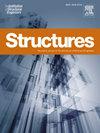预应力混凝土梁抗剪强度数据库评价
IF 4.3
2区 工程技术
Q1 ENGINEERING, CIVIL
引用次数: 0
摘要
预应力混凝土构件的抗剪设计是一项复杂而模糊的任务,目前尚无公认的设计程序。因此,建立一个可靠的数据库来制定这些规则或与实验结果进行比较是至关重要的。在本研究中,收集了预应力混凝土梁的剪切试验的数据库,过滤了266个现有的试验结果。然后,将该数据库应用于5种现行设计规范和2种具有代表性的现有模型,对抗剪强度的预测精度进行了评价。对比结果表明,Marí等方法对预应力混凝土梁的预测精度最高,但COV较大。提出了一种基于桁架-拱模型的简化抗剪强度计算公式,并将该模型的计算结果与预应力混凝土梁的试验结果进行了比较,证明了该模型具有预测预应力混凝土梁抗剪强度的能力。此外,与其他方法相比,该模型具有更好的准确性和一致性。因此,简化公式可作为受剪配筋预应力混凝土梁抗剪强度分析方法的一种可行改进。本文章由计算机程序翻译,如有差异,请以英文原文为准。
Database evaluation of shear strength of prestressed concrete beams
Shear design in prestressed concrete members is a complex and ambiguous task, and there is no recognized design procedure. For this reason, it is crucial to establish a reliable database that can be used to develop these regulations or compare them with experimental results. In this study, a database of shear tests of prestressed concrete beams was collected from filtered 266 existing test results. Then, the database was applied to five current design codes and two representative existing models, to evaluate the prediction accuracy of shear strength. The comparison results showed that Marí et al. method provided the most accurate prediction for prestressed concrete beams, but it had larger COV. A simplified formula of shear strength based on truss-arch model was proposed, and the calculation results of the proposed model were compared with the test results of prestressed concrete beams, which proved that the proposed model had the ability to predict the shear strength of prestressed concrete beams. In addition, compared with other methods, the proposed model showed better accuracy and consistency. Thus, the simplified formula may be a feasible improvement as an alternative shear strength analysis method for prestressed concrete beams with shear reinforcement.
求助全文
通过发布文献求助,成功后即可免费获取论文全文。
去求助
来源期刊

Structures
Engineering-Architecture
CiteScore
5.70
自引率
17.10%
发文量
1187
期刊介绍:
Structures aims to publish internationally-leading research across the full breadth of structural engineering. Papers for Structures are particularly welcome in which high-quality research will benefit from wide readership of academics and practitioners such that not only high citation rates but also tangible industrial-related pathways to impact are achieved.
 求助内容:
求助内容: 应助结果提醒方式:
应助结果提醒方式:


